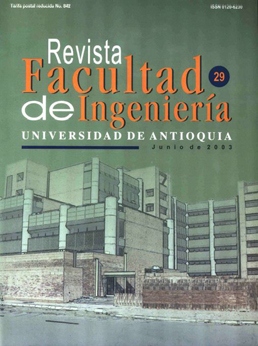Catalytic behavior of Zn(II) and Co(II) molypdates
DOI:
https://doi.org/10.17533/udea.redin.326570Palabras clave:
Transition metal molybdates, hydrothermal synthesis, cyclohexene hydroxylation.Resumen
Isotypic molybdates of Zn(Il) and Co(II) were hydro thermally prepared and the solid products characterized by XRD, TGA, AA, SEM, CHN analysis and N2 adsorption. The materials are layered type and exhibit structures formed by Zn and Co octahedrons and molybdenum tetrahedrons with one vertex unconnected which protrudes into the interlayer space. The catalytic behavior was tested by means of the reaction of cyclohexene hydroxylation with hydrogen peroxide. ZnMo shows high selectivity to 2-cyclohexene-1-ol while CoMo shows lower activity than the blank.Descargas
Citas
Trifiró, F. "Cat. Today". 1998. pp. 41-21. DOI: https://doi.org/10.1016/S0920-5861(98)00035-2
Trifiró, F. et al. "Fourth lnternational Congress on Catalysis". Moscow. 1968. pp. 18.
Pitchai, R. et al. "Cat. Rev-Sci. ". England. 1986. pp. 28-13. DOI: https://doi.org/10.1080/03602458608068085
Mugdan, M. and D. Young. "J. Chem. Soc.". No. 631. 1949. pp. 2.988.
Zhang, Z. et al. "Chem. Commun.". 1998. p.p. 242.
Zhang, Z. et al. "Appl. Cat. A-Gen.". 1999. 179. pp. 11.
POV-Ray™, Version 3.1. 1999.
Kraus, W. and G. Nolze "Powder Cell for Windows, version 2.3". En: Federal Institute for MateRial Research and Testing. No. 5. Berlin. Rudower Chaussee. pp. 12.489
Clearfield, A. et al. "Inor. Chem. ". No. 15. 1976. pp. 335. DOI: https://doi.org/10.1021/ic50156a019
Palacio, L. and C. Saldarriaga. "X-ray powder diffraction data for zinc molybdate, Na(OH)Zn2(MoO4)2.2.5H2O", En: Powder Diffraction. No. 15. 2000. pp. 191. DOI: https://doi.org/10.1017/S0885715600011064
Cotton, A. and G. Wilkinson. "Advanced inorganic chemistry". John Wiley and Sons. Ed. 2. 1966. pp. 373.
Descargas
Publicado
Cómo citar
Número
Sección
Licencia
Los artículos disponibles en la Revista Facultad de Ingeniería, Universidad de Antioquia están bajo la licencia Creative Commons Attribution BY-NC-SA 4.0.
Eres libre de:
Compartir — copiar y redistribuir el material en cualquier medio o formato
Adaptar : remezclar, transformar y construir sobre el material.
Bajo los siguientes términos:
Reconocimiento : debe otorgar el crédito correspondiente , proporcionar un enlace a la licencia e indicar si se realizaron cambios . Puede hacerlo de cualquier manera razonable, pero no de ninguna manera que sugiera que el licenciante lo respalda a usted o su uso.
No comercial : no puede utilizar el material con fines comerciales .
Compartir igual : si remezcla, transforma o construye a partir del material, debe distribuir sus contribuciones bajo la misma licencia que el original.
El material publicado por la revista puede ser distribuido, copiado y exhibido por terceros si se dan los respectivos créditos a la revista, sin ningún costo. No se puede obtener ningún beneficio comercial y las obras derivadas tienen que estar bajo los mismos términos de licencia que el trabajo original.










 Twitter
Twitter